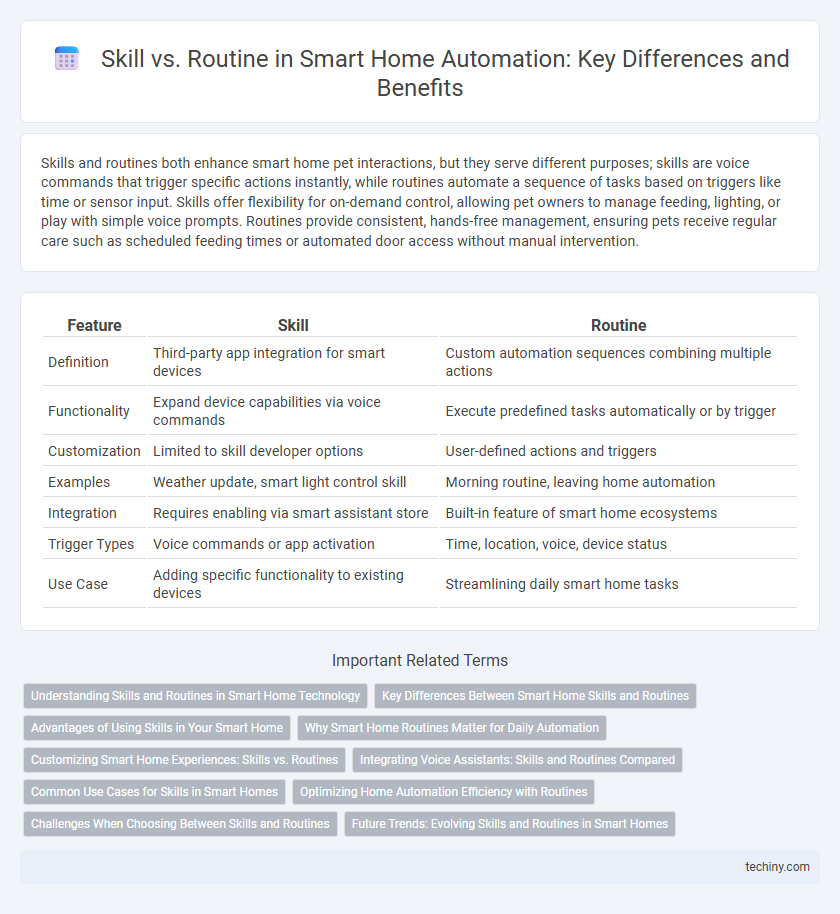Skills and routines both enhance smart home pet interactions, but they serve different purposes; skills are voice commands that trigger specific actions instantly, while routines automate a sequence of tasks based on triggers like time or sensor input. Skills offer flexibility for on-demand control, allowing pet owners to manage feeding, lighting, or play with simple voice prompts. Routines provide consistent, hands-free management, ensuring pets receive regular care such as scheduled feeding times or automated door access without manual intervention.
Table of Comparison
| Feature | Skill | Routine |
|---|---|---|
| Definition | Third-party app integration for smart devices | Custom automation sequences combining multiple actions |
| Functionality | Expand device capabilities via voice commands | Execute predefined tasks automatically or by trigger |
| Customization | Limited to skill developer options | User-defined actions and triggers |
| Examples | Weather update, smart light control skill | Morning routine, leaving home automation |
| Integration | Requires enabling via smart assistant store | Built-in feature of smart home ecosystems |
| Trigger Types | Voice commands or app activation | Time, location, voice, device status |
| Use Case | Adding specific functionality to existing devices | Streamlining daily smart home tasks |
Understanding Skills and Routines in Smart Home Technology
Skills in smart home technology refer to specific voice-activated functionalities or apps that enable devices to perform tasks such as controlling lights or playing music. Routines are customizable sequences of multiple commands triggered by a single phrase or event, automating various smart home devices simultaneously. Understanding the distinction between skills and routines allows users to optimize their smart home experience by leveraging individual device capabilities and creating integrated automation workflows.
Key Differences Between Smart Home Skills and Routines
Smart home skills are voice-activated commands enabling devices to perform specific functions through platforms like Alexa or Google Assistant, while routines automate multiple actions based on triggers such as time or sensor input. Skills expand device capabilities by integrating third-party services, offering task-specific interactions, whereas routines streamline daily activities by combining several commands into a single automated sequence. Understanding these differences helps optimize smart home setups for personalized convenience and efficiency.
Advantages of Using Skills in Your Smart Home
Using skills in your smart home enhances device interoperability and expands functionality by enabling seamless integration with multiple platforms and services. Skills provide customizable voice commands and automate complex tasks, increasing convenience and efficiency in daily routines. Leveraging skills also allows continual updates and new feature additions, ensuring your smart home stays adaptive and future-proof.
Why Smart Home Routines Matter for Daily Automation
Smart home routines automate multiple tasks through a single command, increasing efficiency and convenience in daily life. Unlike individual skills that perform specific actions, routines combine numerous commands to execute complex sequences, enhancing user experience. This integration reduces manual input, streamlines home management, and optimizes energy usage.
Customizing Smart Home Experiences: Skills vs. Routines
Customizing smart home experiences involves understanding the distinction between skills and routines. Skills extend device capabilities by integrating third-party services, enabling voice commands for specific tasks, while routines automate multiple actions triggered by a single command or event. Leveraging both skills and routines enhances personalized control, streamlining daily activities with tailored automation and expanded functionality.
Integrating Voice Assistants: Skills and Routines Compared
Skills in smart home voice assistants are specialized apps that enable specific functions such as controlling lights or setting reminders, while routines automate a sequence of actions triggered by a single command or event. Skills expand the assistant's capabilities by integrating third-party services, providing granular control over smart devices. Routines streamline daily automation by combining multiple skills and device controls into one cohesive command, enhancing user convenience and efficiency.
Common Use Cases for Skills in Smart Homes
Skills in smart homes enable voice-activated control of devices such as lighting, thermostats, and security systems, streamlining everyday tasks. Common use cases include managing smart appliances, setting reminders, and accessing entertainment services through voice assistants like Amazon Alexa or Google Assistant. These skills enhance user convenience by automating frequent actions and integrating diverse smart home components.
Optimizing Home Automation Efficiency with Routines
Routines in smart home systems streamline automation by executing multiple actions with a single command, enhancing efficiency and user convenience. Unlike individual skills that perform isolated functions, routines integrate various devices and settings to create seamless, context-aware environments. Optimizing home automation with routines reduces manual input, saves time, and ensures consistent control over lighting, climate, security, and entertainment.
Challenges When Choosing Between Skills and Routines
Selecting between skills and routines in smart home systems often presents challenges related to compatibility and customization limitations. Skills, designed for specific tasks, may lack the flexibility needed for multiple simultaneous actions, while routines offer broader automation but can be complex to configure effectively. Users must consider device ecosystem integration, ease of use, and the need for personalized automation when deciding the optimal approach.
Future Trends: Evolving Skills and Routines in Smart Homes
Future trends in smart homes indicate an increasing integration of AI-driven skills and routines that adapt dynamically to user behavior and preferences. Skills will evolve to provide more personalized, context-aware interactions, while routines will become fluid sequences triggered by complex environmental and biometric data. This evolution enhances automation precision, energy efficiency, and overall user convenience in connected living spaces.
Skill vs Routine Infographic

 techiny.com
techiny.com